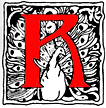No one who has yet to try this particular branch of photography, can possibly appreciate its troubles and disappointments. As an instance of the latter, my brother on one occasion travelled upwards of five hundred miles by rail, and dragged his camera at least twelve miles up and down a mountain side, in order to take a view of one bird’s nest, and was defeated by the oncoming of a thick mist at the very moment he was fixing up his apparatus. The Golden Eagle’s eyrie was photographed during the temporary lifting of a Highland mist, and considering the situation, and the unsatisfactory state of the light, has turned out very successfully. — Kearton, British Birds' Nests, p. xiv.

Head photograph fpr introduction to Wild Nature's Ways,ix.

ichard Kearton (1862-1928) and his younger brother Cherry Kearton (1871-1940) were born of farming stock in Thwaite, a small village in Swaledale, in the Yorkshire Dales. But their father, and indeed his father before him, were keen ornithologists, and both Richard and Cherry, in turn, gave up farmwork to pursue a career in that line — except that, for them, bird-watching would become much more than a hobby, and would be shared with others through the developing technology of photography. Richard started off as a farmer but then made his way to London, where he became manager of Cassell's publicity department. Their father died when Cherry was only fourteen, but, having helped to support the family for several years, and having saved up enough money to buy a camera, he too left home and set off for the capital. By then, Richard had already made a name for himself as a wildlife photographer, and was working for Cassell. He had noticed Cherry's talent, and was in an ideal position to capitalise on it. Collaborations like British Birds' Nests (1898), and the brothers' book of their photographs and experiences, With Nature and a Camera, became bestsellers, and many more followed.



How it was done: (a) "Photographing a Nest in a Tree," With Nature and a Camera, p. 243. (b) "Method of Photographing Birds' Nests Situated in High Hedges," With Nature and a Camerap. 349. (c) "The Stuffed Ox in Operation," Wild Nature's Ways. p. 5.
Cherry was the main photographer of the two: The Photographic Times reported, "Mr. Kearton, who is a Yorkshireman, is more than a camera operator with a love of adventure; he is a naturalist of the new school, and, working in conjunction with his brother Richard, who does the writing, he is making natural history interesting..." ("Filming a Lion," 34). As the source of that quotation suggets, Cherry went on to travel widely and film more exotic creatures than British birds: "According to Kearton’s own memoirs, he filmed kingfishers, non-passerine birds, chameleons, hippopotamuses, lions, jackals, marabous, vultures, colobus monkeys, buffaloes, and Jackson’s dancing birds; and he is also supposed to have filmed a war dance of the Masai people" (Petterson 76). The brothers went from their humble beginnings to being internationally famous. As early as 1908, Richard was invited to to give a talk at the White House in America, and Cherry went on to have some extraordinary adventures filming orangutangs in Borneo and tigers and many other species in Africa, India, and elsewhere.
Works
Bibliography
"Filming a Lion." The Photographic Times." XLV (1913) (from an issue of April 1913): 34-36. Internet Archive, from a copy in the Getty Research Institute. Web. 8 July 2023.
Kearton, Richard. British Birds' Nests: How, Where and When to Find and Identify Them. Illustrated by Photographs by C. Kearton. London, Paris and Melbourne: Cassell, 1895. Internet Archive, from a copy in the Smithsonian Libraries. Web. 8 July 2023.
_____. Wild Nature's Ways. London, Paris and Melbourne: Cassell, 1903. Internet Archive, from a copy in the American Museum of Natural History Library. Web. 8 July 2023.
_____. With Nature and a Camera; being the adventures and observations of a field naturalist and an animal photographer. London, Paris and Melbourne: Cassell, 1898. Internet Archive, from a copy in the library of the American Museum of Natural History. Web. 8 July 2023.
Petterson, Palle B. Cameras into the Wild: A History of Early Wildlife and Expedition Filmmaking, 1895-1928. Jefferson, North Carolina and London: McFarland, 2011.
White, Gilbert. The Natural History of Selbourne, with Notes by Richard Kearton, FZS, FHPS, and 123 Illustrations from Photographs by Cherry and Richard Kearton. 1902. London, New York, Toronto and Melbourne: Cassell, 1911. Internet Archive, from a copy in the Wellcome Institute. Web. 8 July 2023.
Created 8 July 2023